Japan is 6th and Belgium 10th on the Children’s Well-being Index (No.42)
UNICEF recently announced the results of their survey on the “Children’s Level of Well-being in Developed Countries”. The survey took data from just thirty-one developed countries where such data was available and calculated an overall ranking based on the average ranking in five fields such as “material affluence”, “health and safety” and “education”. If we look at the result of Japan closely, Japan is ranked low for “material affluence” (relative poverty rate, poverty gap, etc.), but is number one for “education” (such as the higher education enrolment rate, NEET rate, educational achievement, etc.) and “risks at daily life” (such as obesity, drinking and teenage pregnancies). This puts Japan sixth in the overall ranking. Belgium, on the other hand, is ranked 3rd for “education” and is ranked higher than the overall average for “health and safety” and “housing and environment”. Though ranked slightly lower for “risks at daily life”, Belgium takes up a good position, the 10th, in the overall ranking. Ranked first in the overall ranking is the Netherlands, followed by the Nordic countries and Germany. What is surprising is the low ranking of Anglo-Saxon countries. Although the United Kingdom takes up the 17th position, Canada is 23rd and the United States 29th which is almost the bottom. In the case of Belgium and Japan, most survey items score higher than average on the whole, but remarkably very low-scoring items are noted as well. Japan is ranked 26th for the “children’s poverty gap” and “percentage of infants born with low birth weight (less than 2500 g) and Belgium takes the 20th position for “youth mortality rate (such as suicide) and the 24th position for “bullying”. I think that opinions on how to measure the well-being of children may vary, but this data by UNICEF is nevertheless meaningful for reference.
<Oberammergau NATO Symposium>
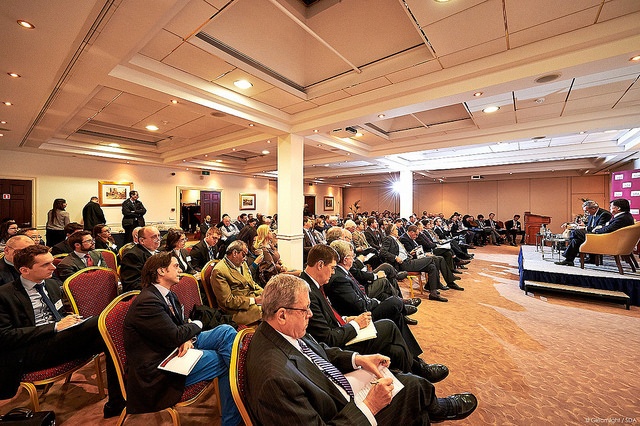 About 10 days ago, a NATO symposium was held in the small town of Oberammergau near the Swiss border about 90 km from Munich. The theme was the future perspective of “partner countries” developing partnerships with NATO which is also greatly related to Japan. A seminar with the same theme was also held by a private think tank in Brussels last week. As you know, NATO is a security organization of the Euro-Atlantic area consisting of 28 member countries. Since the end of the Cold War in the 1990s, NATO has put an emphasis on cooperation with “non-member countries sharing interests” (partner countries). In particular when the Afghanistan issue occurred in the beginning of the 21st century, ground troops were dispatched from over 20 non-member countries leading to a deployment of joint military operations to reinforce counter-terrorism measures. Today, non-member countries such as Australia, Sweden and South Korea have dispatched combat units of more than 1000 soldiers in total to Afghanistan. However, this combat mission in Afghanistan will end by the end of this year. How NATO and non-member countries will put the experience acquired during the joint military operations to use in the future is the challenge. About 10 days ago, a NATO symposium was held in the small town of Oberammergau near the Swiss border about 90 km from Munich. The theme was the future perspective of “partner countries” developing partnerships with NATO which is also greatly related to Japan. A seminar with the same theme was also held by a private think tank in Brussels last week. As you know, NATO is a security organization of the Euro-Atlantic area consisting of 28 member countries. Since the end of the Cold War in the 1990s, NATO has put an emphasis on cooperation with “non-member countries sharing interests” (partner countries). In particular when the Afghanistan issue occurred in the beginning of the 21st century, ground troops were dispatched from over 20 non-member countries leading to a deployment of joint military operations to reinforce counter-terrorism measures. Today, non-member countries such as Australia, Sweden and South Korea have dispatched combat units of more than 1000 soldiers in total to Afghanistan. However, this combat mission in Afghanistan will end by the end of this year. How NATO and non-member countries will put the experience acquired during the joint military operations to use in the future is the challenge.
 Since I was asked as a keynote speaker and panelist in the symposium and seminar, I explained the Japanese view on the future relationship between NATO and the partner countries. Japan did not take part in NATO’s military operations in Afghanistan, but did deepen its cooperation with NATO by funding literacy education and medical service for the Afghanistan National Security Force and by donating funds through United Nations for the payment of the salaries of the Afghanistan Police. A fleet of the Maritime Self-Defence Force has been dispatched to help counter piracy off the coast of Somalia together with fleets of NATO and EU. Although Japan has become an important partner country for NATO, when it comes to how to deepen the cooperative relationship in the future, many challenges lie ahead on the Japanese side. I stressed that NATO’s partnership policy “should have values such as freedom and democracy as a basis” and furthermore that “we should build partnerships in a global scope” beyond Europe and the Atlantic Ocean, NATO’s original area of activities, because of the need for a global approach to new security challenges such as cyber-attacks, counterterrorism and maritime security. Japan is an advocate of a “proactive contribution to peace” under the Abe administration. However, in the relationship with NATO, Japan needs to consider seriously what Japan can do beyond the conventional cooperation programs such as information exchange, people-to-people exchanges and financial cooperation. Since I was asked as a keynote speaker and panelist in the symposium and seminar, I explained the Japanese view on the future relationship between NATO and the partner countries. Japan did not take part in NATO’s military operations in Afghanistan, but did deepen its cooperation with NATO by funding literacy education and medical service for the Afghanistan National Security Force and by donating funds through United Nations for the payment of the salaries of the Afghanistan Police. A fleet of the Maritime Self-Defence Force has been dispatched to help counter piracy off the coast of Somalia together with fleets of NATO and EU. Although Japan has become an important partner country for NATO, when it comes to how to deepen the cooperative relationship in the future, many challenges lie ahead on the Japanese side. I stressed that NATO’s partnership policy “should have values such as freedom and democracy as a basis” and furthermore that “we should build partnerships in a global scope” beyond Europe and the Atlantic Ocean, NATO’s original area of activities, because of the need for a global approach to new security challenges such as cyber-attacks, counterterrorism and maritime security. Japan is an advocate of a “proactive contribution to peace” under the Abe administration. However, in the relationship with NATO, Japan needs to consider seriously what Japan can do beyond the conventional cooperation programs such as information exchange, people-to-people exchanges and financial cooperation.
<A Report on Japan by a Belgian Journalist >
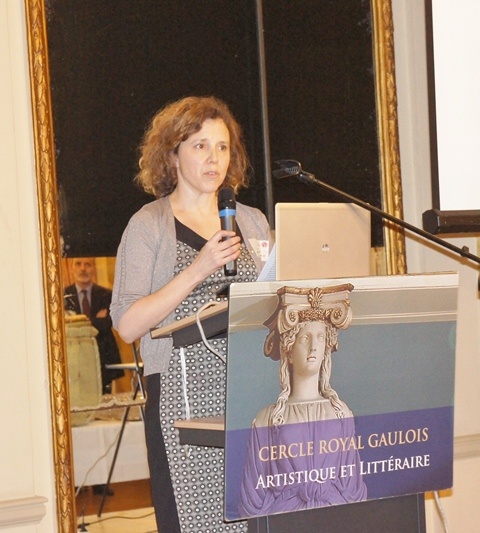 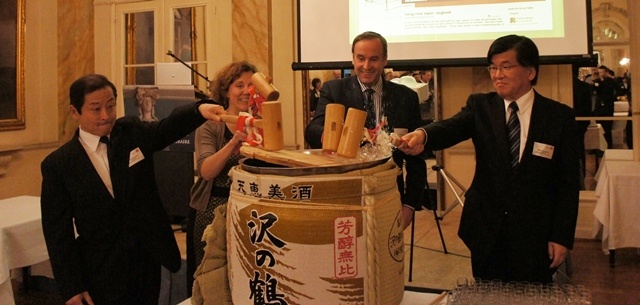 The week before last, about 150 people attended the New Year’s reception of the BJA (Belgium-Japan Association) held in the center of Brussels. Celebrating its 50th anniversary last year, the BJA has grown into an important organization supporting from the private sector mutual friendship relationships between both countries, counting mainly people from both Japanese and Belgian companies among its members. Thomas Leysen, Chairman of Umicore, and I broke open a sake barrel to celebrate the New Year, just like last year. As a special project for the New Year’s reception this year, a female journalist from a local radio station who travelled in Japan for two weeks for collecting data last September reported about her news coverage in Japan. The journalist received a grant from the BJA-managed Marilo Fund for her coverage and after her return a 5-day long “Japan Travel Diary” was broadcast on a Dutch language radio station. The topics dealt with varied greatly from the aging society and social advancement of women to environmental issues and Abenomics. She seems to have made various discoveries about Japan’s current situation and reported that Belgium, which is facing similar economic and social problems, could learn many things from Japan. What was surprising to me was her coverage of the depopulation problem in a small island in the Seto Inland Sea. She focused on the phenomenon of young people returning to the island after having left and how Belgians should learn from senior volunteers who keep contributing to society even after retirement. In the part where she reported on the smooth coverage thanks to Japan’s impeccable public transport system, I also felt strong irony for the flaws in Belgium’s public transport. Well, the Japanese may take this for granted, but for many foreigners it is a new surprise. The week before last, about 150 people attended the New Year’s reception of the BJA (Belgium-Japan Association) held in the center of Brussels. Celebrating its 50th anniversary last year, the BJA has grown into an important organization supporting from the private sector mutual friendship relationships between both countries, counting mainly people from both Japanese and Belgian companies among its members. Thomas Leysen, Chairman of Umicore, and I broke open a sake barrel to celebrate the New Year, just like last year. As a special project for the New Year’s reception this year, a female journalist from a local radio station who travelled in Japan for two weeks for collecting data last September reported about her news coverage in Japan. The journalist received a grant from the BJA-managed Marilo Fund for her coverage and after her return a 5-day long “Japan Travel Diary” was broadcast on a Dutch language radio station. The topics dealt with varied greatly from the aging society and social advancement of women to environmental issues and Abenomics. She seems to have made various discoveries about Japan’s current situation and reported that Belgium, which is facing similar economic and social problems, could learn many things from Japan. What was surprising to me was her coverage of the depopulation problem in a small island in the Seto Inland Sea. She focused on the phenomenon of young people returning to the island after having left and how Belgians should learn from senior volunteers who keep contributing to society even after retirement. In the part where she reported on the smooth coverage thanks to Japan’s impeccable public transport system, I also felt strong irony for the flaws in Belgium’s public transport. Well, the Japanese may take this for granted, but for many foreigners it is a new surprise.
<BRAFA: Aristocracy and Antiquities>
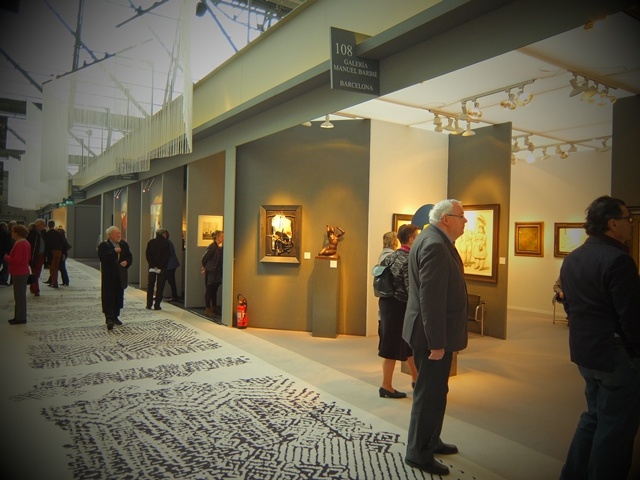 Until yesterday an Art Fair (exhibition and sales) called “BRAFA” was held in a huge trade fair center in Brussels. The 59th fair ran from January 25 for 9 days. I was invited for an exclusive viewing the day before the official opening. I got to see to my heart’s content the splendour of European antiques. Over 130 art dealers had galleries at the fair and it felt just like a grand art museum. Many high-quality works from paintings and sculptures to several sorts of jewelry and ornaments were on display. Amongst which was also a gallery dedicated to Edo-period arms and hanging scrolls. I found a nice-looking brooch in the shape of a bird at a gallery displaying women’s ornaments. When I asked the price, for reference, I was baffled upon hearing it costs 40,000 euro. Every year, there’s a national tradition in Belgium that the king makes new members of the aristocracy by bestowing titles. As there is still old nobility living in castles as well, the antiques sales seem to be thriving. “TEFAF”, the largest Antiques Fair (exhibition and sale) in Europe, is held every year in Maastricht in the Netherlands (110 km to the east of Brussels). Compared to this fair, the one in Brussels is much smaller in size. Nevertheless, I would imagine it remains enjoyable and exciting for enthusiasts and collectors. Until yesterday an Art Fair (exhibition and sales) called “BRAFA” was held in a huge trade fair center in Brussels. The 59th fair ran from January 25 for 9 days. I was invited for an exclusive viewing the day before the official opening. I got to see to my heart’s content the splendour of European antiques. Over 130 art dealers had galleries at the fair and it felt just like a grand art museum. Many high-quality works from paintings and sculptures to several sorts of jewelry and ornaments were on display. Amongst which was also a gallery dedicated to Edo-period arms and hanging scrolls. I found a nice-looking brooch in the shape of a bird at a gallery displaying women’s ornaments. When I asked the price, for reference, I was baffled upon hearing it costs 40,000 euro. Every year, there’s a national tradition in Belgium that the king makes new members of the aristocracy by bestowing titles. As there is still old nobility living in castles as well, the antiques sales seem to be thriving. “TEFAF”, the largest Antiques Fair (exhibition and sale) in Europe, is held every year in Maastricht in the Netherlands (110 km to the east of Brussels). Compared to this fair, the one in Brussels is much smaller in size. Nevertheless, I would imagine it remains enjoyable and exciting for enthusiasts and collectors.
<Unesco Heritage: the Strépy-Thieu Boat Lift>
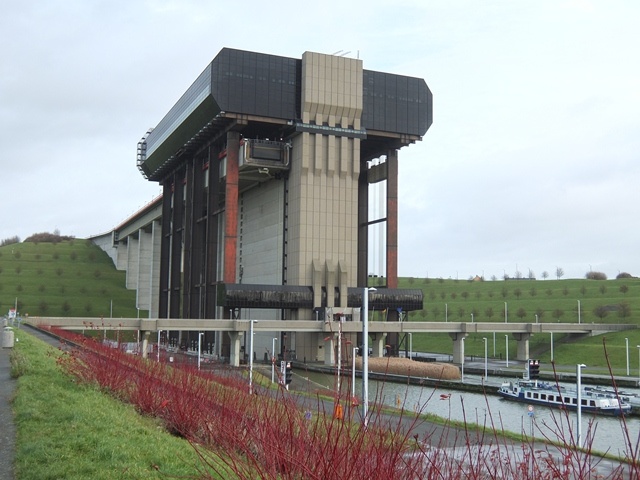 The Meuse River, flowing from south to north through the city center of Namur connects with Germany in the east of Belgium. The west of Belgium is connected to France through the Escaut River which runs from south to north through the city of Kortrijk. To connect these two rivers from east to west the Canal du Centre was opened. This waterway, connecting Germany via Belgium to France, was the direct main line for the distribution of goods in the 19th century. However, just outside Mons (67 km to the southwest of Brussels) the height difference is over 70m, so to traverse this point one had to reload one’s wares onto another ship. In order to solve this problem, a huge boat lift using hydraulic pressure was constructed from the end of the 19th century to the beginning of the 20th century. It was inscribed on the UNESCO World Heritage List in 1998. It is said that the Strépy-Thieu boat lift shows the culmination of water engineering development in Europe of its time. I went there by car the other day and seeing the huge size of the lift with a height of 110m and a length of 130m was the highlight of my visit. However, the Strépy-Thieu boat lift is currently not in use anymore. Running parallel is another canal where in 2002 four new boat lifts were built. Where it would take a 300-ton ship 5 hours in the past, it now takes for ships up to 1350 tons just 2 hours to pass through. Travelling through Belgium it is amazing to see that the rivers flow freely everywhere and that the canals are opened up. Even in today’s age of developed railroads and motorways canals still continue to play an important role in Belgium. The Meuse River, flowing from south to north through the city center of Namur connects with Germany in the east of Belgium. The west of Belgium is connected to France through the Escaut River which runs from south to north through the city of Kortrijk. To connect these two rivers from east to west the Canal du Centre was opened. This waterway, connecting Germany via Belgium to France, was the direct main line for the distribution of goods in the 19th century. However, just outside Mons (67 km to the southwest of Brussels) the height difference is over 70m, so to traverse this point one had to reload one’s wares onto another ship. In order to solve this problem, a huge boat lift using hydraulic pressure was constructed from the end of the 19th century to the beginning of the 20th century. It was inscribed on the UNESCO World Heritage List in 1998. It is said that the Strépy-Thieu boat lift shows the culmination of water engineering development in Europe of its time. I went there by car the other day and seeing the huge size of the lift with a height of 110m and a length of 130m was the highlight of my visit. However, the Strépy-Thieu boat lift is currently not in use anymore. Running parallel is another canal where in 2002 four new boat lifts were built. Where it would take a 300-ton ship 5 hours in the past, it now takes for ships up to 1350 tons just 2 hours to pass through. Travelling through Belgium it is amazing to see that the rivers flow freely everywhere and that the canals are opened up. Even in today’s age of developed railroads and motorways canals still continue to play an important role in Belgium.
|